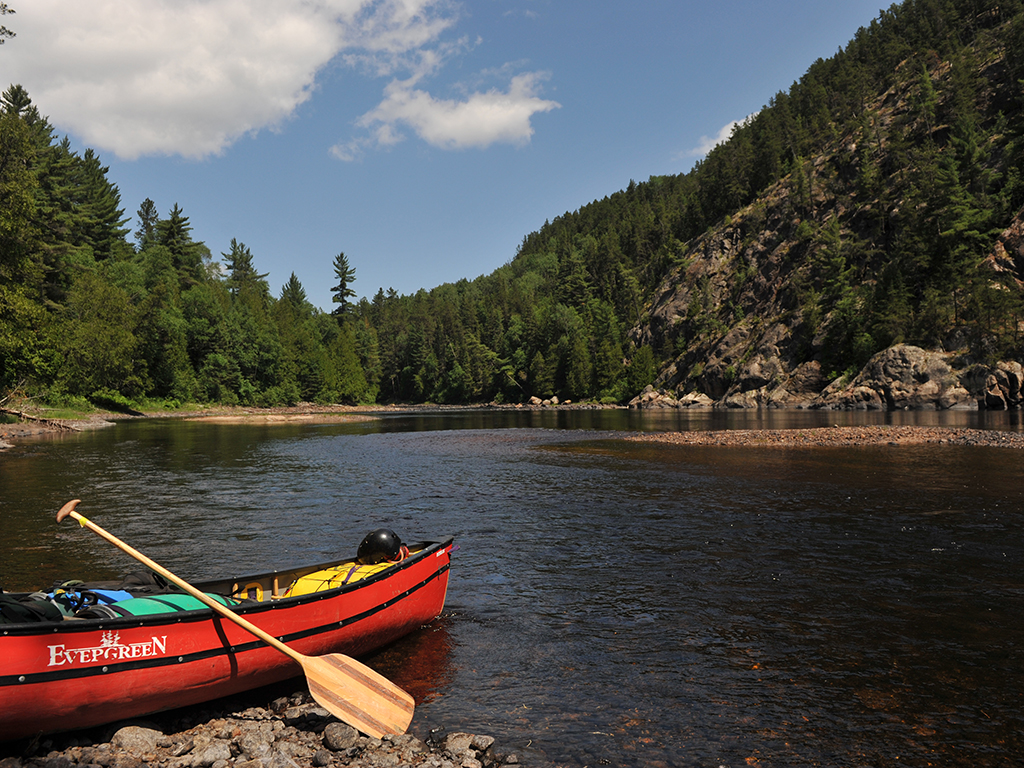The weathered silver passenger train rolled through the thick northern Ontario forest and screeched to a halt in the middle of nowhere. I peered out of the window and noticed a frail old man with a battered brown suitcase and chainsaw slowly get off. The train’s baggage handlers helped the stooped man with more boxes and bags until a heap formed along the tracks.
“Oh, he’s been coming up from Sudbury for the last few years and lives in a tent for a month at a time,” explained Via Rail employee Germain Paquette, as we started down the track again. “Yup, he’s 72 years old. He must really like it out here.”
Not far along, the train stopped again in the bush beside a waiting middle-aged couple who exchanged a cooler of ice for a bag of filleted fish with Germain through the train’s window.
“I don’t even have to go fishing,” he said, holding up the bag with a grin as we kept travelling north.
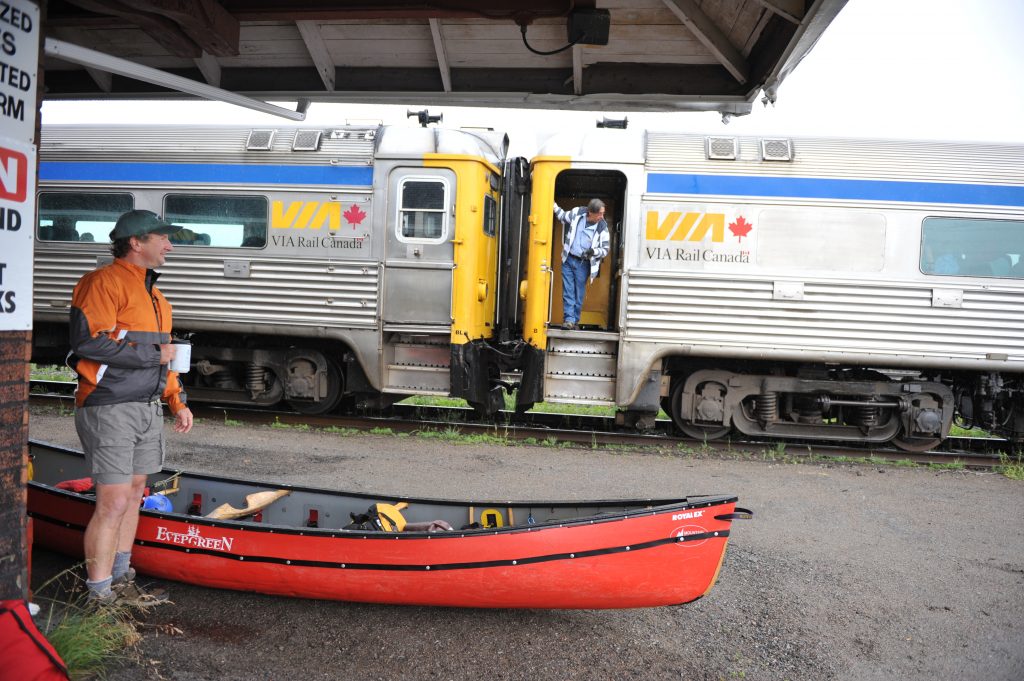
Within a half hour we stopped once more and I helped take supplies off the baggage car for Cy and Gail Tulk, a couple who, I guessed were also in their seventies, were getting ready to open up a fishing lodge on a lake near the Spanish River they’ve been running for the past 43 years. Earlier, we had got to talking and heard some great old stories about riding the train in the old days. “Everyone used to drink back then,” Cy explained. “Usually they would all go back to the baggage car and it would be a real party. True story – one time, the crew and passengers on board thought the conductor had a few too many beers and told him he wasn’t allowed to have any more. Well, the conductor stopped the train and refused to go on unless someone gave him another beer.”
Two hours from where my wife Marilyn and I boarded the train at Cartier, a small town about 60 kilometres west of Sudbury, we reached the hamlet of Biscotasing, on the shore of Biscotasi Lake. The community was the former home of Englishman Archey Belaney in the early 1900’s who was better known as Grey Owl, the famous wildlife conservationist, author, and lecturer who few knew was not Aboriginal until after his death.
That was how we began a week-long canoe trip 164 kilometres on the Spanish River south to Agnew Lake Lodge near Highway 17 where our car was waiting for us after being shuttled from Cartier by a local outfitter.
As we paddled on the vast lake a day’s journey to the mouth of the river, I thought what a fascinating train trip it had been – a frontier throwback to the 1940’s and 50’s where people are still using the rail to get to town, carry supplies, or as a means to get to their camps and lodges. Even for a school group of kids from Sudbury we saw cheerfully getting off at Cartier, the ride was unique enough to be a field trip. Most of them, including the teachers, had never been on a train before.
And how truly Canadian it felt to load our canoe and equipment barrels onto a rail car and be able to get off or get picked up virtually anywhere on the route from Sudbury to White River. Germain, who has spent 14 years working on the railway, said trains are a popular way for paddlers to access the rivers in the area. It’s an inexpensive transportation option and paddlers can choose to take as long a trip as they wish.
“The most canoes I ever took on the Spanish at one time was 32,” he said. “ (I) Stacked them all up on each other in the baggage car.”
Though Marilyn and I were enticed to run the Spanish River by the romantic notion of taking a train to the put-in, it was the river itself that really attracted us and the many other paddlers of all skill levels each year. The Spanish offers everything a canoeist could want – constantly changing scenery, lots of wildlife, easy access by rail or road, some excellent rapids to run. And since the Spanish has provincial park designation, the government maintains campsites and portages around all of the rapids in case they’re looking too challenging.
There are a number of options to begin a trip, including the popular and more relaxing east branch that features a series of narrow lakes and swifts and is a slightly shorter trip than the west branch but access is only by road.
We decided to paddle the more rugged west branch that begins at Biscotasi Lake and we were lucky there was no wind to kick up big waves on the shallow lake. Unfortunately, the big rapids we were hoping to run were reduced to a mere trickle because of record low water levels this summer and we spent much of the time pulling the canoe over rocks in the river, which is only slightly easier than portaging around the rapids. At least, the scenery was beautiful with its mix of rocky shorelines, marshes, and moss laden forests. We had that part of the river all to ourselves for the first few days and agreed that we would definitely return some day when the water level was higher so we could run the rapids.
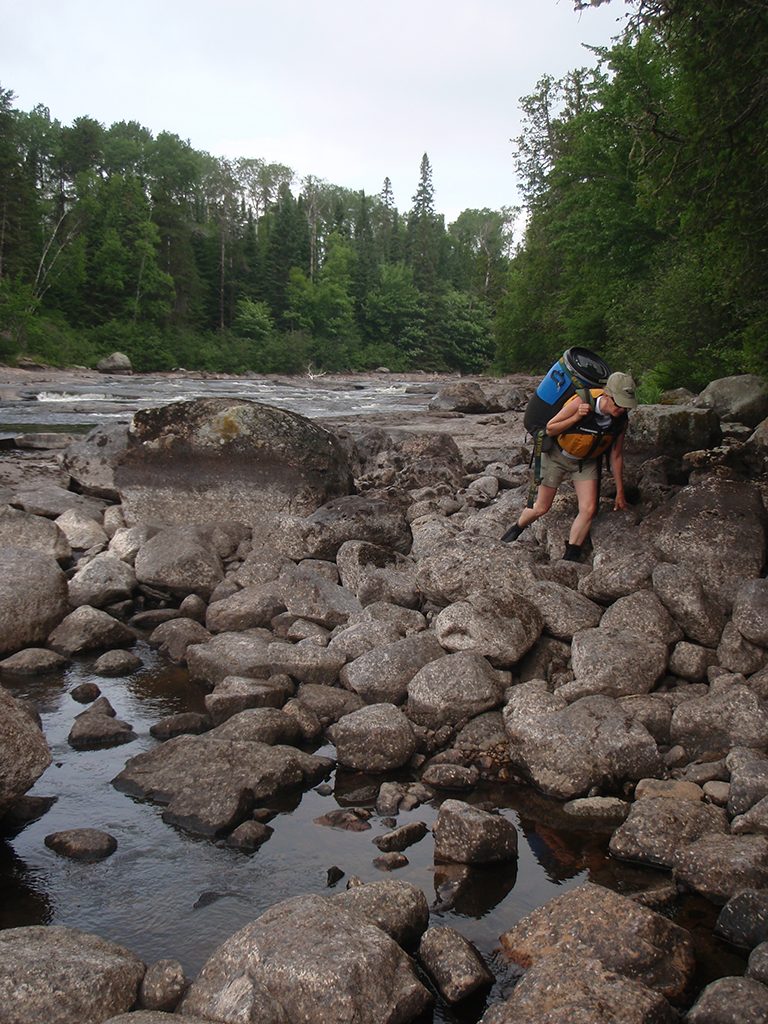
The other main access point is a bend in the river called the Elbow about halfway down the 100 kilometre stretch between the “Fork” where the river branches meet and Agnew Lake. Some people prefer to end their trip at the Elbow since just downstream awaits a challenging and potentially dangerous set of rapids ledges, and falls ominously called “The Graveyard”. We managed to run nearly all of the whitewater but a severely wrecked canoe downstream didn’t go unnoticed – it was a healthy reminder of the power of water and rock.
But persevere and you will be rewarded. Not far past “The Graveyard” begins the “Royal Ride” – more than 20 kilometres of constant swifts and fast water that took the work out of canoeing except to try to find the deep water channels so we wouldn’t hit bottom. Along the banks, ancient towering red and white pine rose up beside us and at the mouth of one creek we pulled ashore to gaze across the river at a large expanse of pristine old growth forest that survived loggers’ saws as far back as 1863.
The overlapping of boreal and hardwood forest habitats in the Spanish River area are home to a variety of bird life and animals, including black bear, lynx and Timber wolves. One afternoon, we saw a young moose cautiously eyeing us as it fed close to shore, and we lost count of the beavers that confidently swam near us as the days went by.
We watched Sandhill cranes prancing around a marsh for fish and ospreys gliding overhead in search of Bufflehead ducklings that nervously stayed with their mother until our canoe came near. Then, they would quickly dive underwater, popping up and down again if we got too close.
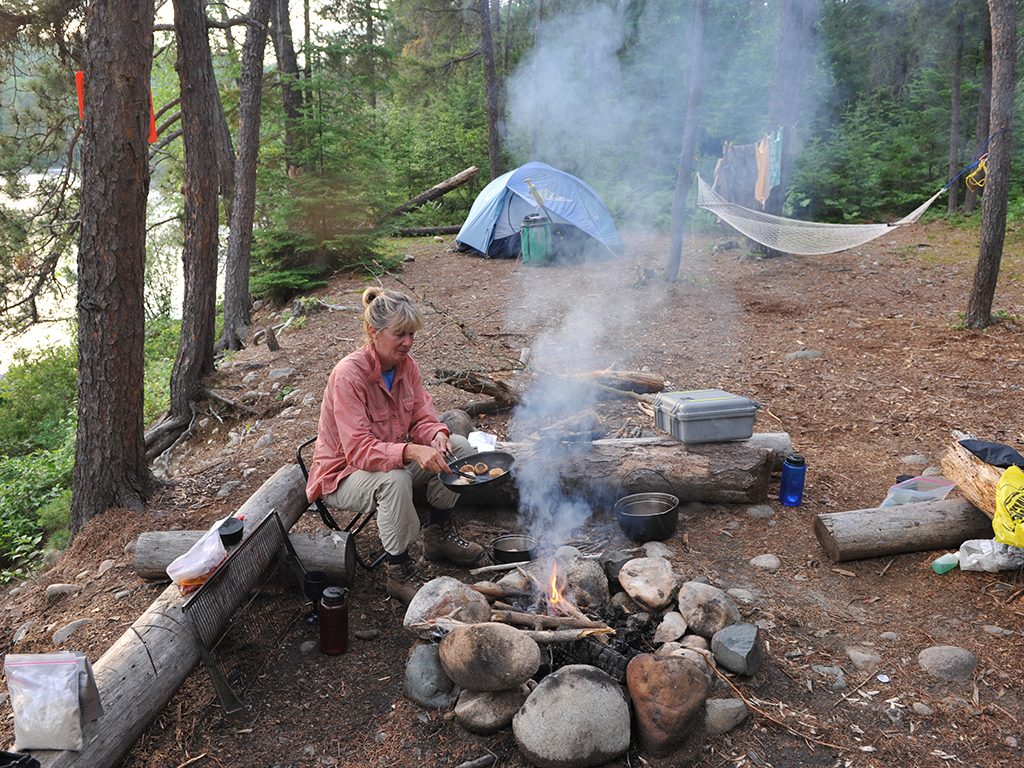
On one particular evening, we pulled into a campsite and began unpacking our equipment and setting up a tarp for another rainy night. Suddenly, a rabbit hopped into view, stopped and calmly scratched its ear with its back foot. Marilyn whispered for me to get the camera and I slowly rose to take a picture, afraid to scare the animal off. Surprisingly, the rabbit hopped closer and then it began investigating the whole campsite, chewing at our tent and barrel straps, and coming so close I thought it would go for my leg. Eventually, Marilyn chased it away by banging on a pot.
One of the most memorable experiences of the trip was the afternoon we paid a visit to Cy and Gail who were preparing their lodge on Pogamasing Lake for their first clients of the season – a group of eight American fishermen who were coming in for the week to fish for Northern pike, small mouth bass, walleye, all common to the Spanish River area.
After a short walk on a rough dirt road we reached the lake where a Hudson Bay Trading Post was once situated on a nearby island from 1869 to 1885. We knocked on the main timber-built lodge and Cy and Gail warmly invited us in for coffee and doughnuts where we were introduced to Ed, a fishing guide from Manitoulin Island who worked for them for 18 years.
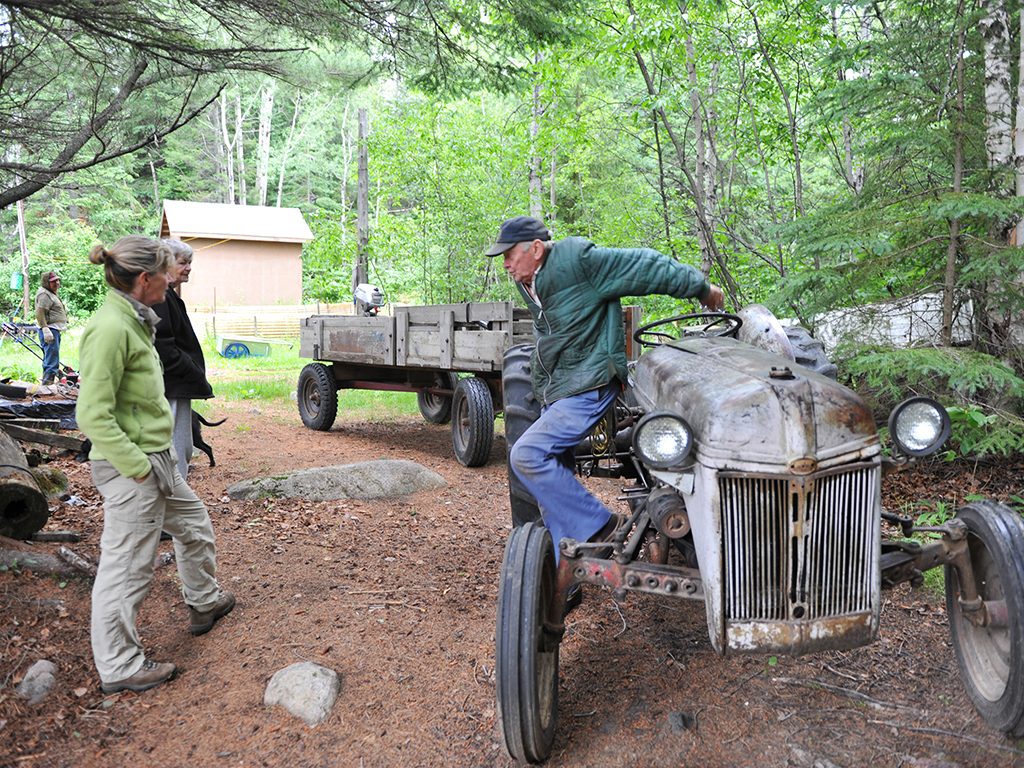
Later, we toured the property of expertly crafted buildings Gail’s parents built in 1948 and we were shown some intriguing items such as a gun rack made of deer hooves, a kangaroo hide given by a client, a WWII amphibious “Duck” vehicle, a tractor built in 1953 they still used to haul equipment , and a dry sauna built more than 50 years ago that was still going strong.
Shortly before we said goodbye, Cy mentioned that he had been an entertainer and with a little urging we learned that he was once a country singer who toured with Johnny Cash and turned down an offer to be signed to a major U.S. recording label. Cy showed us a CD with photo of himself and guitar in his heydays.
“You gave it up to be up here?” I asked.
“Just look around you,” he replied.
That was answer enough.
Story by Ralph Plath
Photos by Ralph Plath
and Marilyn Mikkelsen
Getting There
There are various options by road or rail depending on the length and difficulty of trip you want. For an easier trip of 145 kilometres (a seven to 10 day paddle), take the East Branch down to Agnew Lake. This trip begins at Duke Lake at the top of the East Branch and is accessed via a gravel road from Hwy 144 about 1.5 hours northwest of Sudbury.
For a more difficult trip that is about 20 kilometres longer and has more whitewater and portages, paddle the West Branch from Biscotasi Lake down to Agnew Lake. You can catch a Via Rail train at Sudbury or Cartier. The cost is $21 per person and $20 for a canoe. Equipment is free.
The drive to Sudbury takes about five hours from Ottawa on Highway 17 and another 45 minutes west on Hwy 17 and north on Hwy 144 if you want to catch the train at Cartier.
For more information, contact Via Rail:
– website – www.viarail.ca
– tel. – 1-888-842-7245 (Montreal)
or 705-673-1138 (Sudbury)
For shorter trips, Via Rail will also drop you off or pick you up at other points along the river as long as you give them prior notice. There is also gravel road access and room to park cars at the Elbow just above Graveyard Rapids to put-in or take out.
Spanish River Outfitters is located not far from there and offers vehicle shuttling services and canoe rentals.
– website – www.foxlakelodge.com
– tel. 1-705-965-2701
The most popular take-out is Agnew Lake Lodge which also offers shuttling services and canoe rentals.
– website: www.agnewlakelodge.com
– tel. – 1-877-299-6098
Since the Spanish River is a provincial park, camping fees are also required. Fees are $9.50 per person per night.
More information
Chrismar Adventure Maps produces an excellent waterproof map with detailed information that is essential to running the river. The map costs $12.95 and can be found at World of Maps and various outdoor stores in Ottawa.

